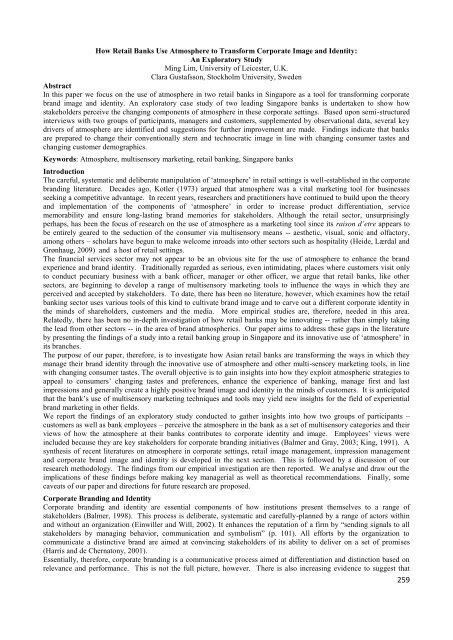Brand, Identity and Reputation: Exploring, Creating New Realities ...
Brand, Identity and Reputation: Exploring, Creating New Realities ...
Brand, Identity and Reputation: Exploring, Creating New Realities ...
Create successful ePaper yourself
Turn your PDF publications into a flip-book with our unique Google optimized e-Paper software.
How Retail Banks Use Atmosphere to Transform Corporate Image <strong>and</strong> <strong>Identity</strong>:<br />
An Exploratory Study<br />
Ming Lim, University of Leicester, U.K.<br />
Clara Gustafsson, Stockholm University, Sweden<br />
Abstract<br />
In this paper we focus on the use of atmosphere in two retail banks in Singapore as a tool for transforming corporate<br />
br<strong>and</strong> image <strong>and</strong> identity. An exploratory case study of two leading Singapore banks is undertaken to show how<br />
stakeholders perceive the changing components of atmosphere in these corporate settings. Based upon semi-structured<br />
interviews with two groups of participants, managers <strong>and</strong> customers, supplemented by observational data, several key<br />
drivers of atmosphere are identified <strong>and</strong> suggestions for further improvement are made. Findings indicate that banks<br />
are prepared to change their conventionally stern <strong>and</strong> technocratic image in line with changing consumer tastes <strong>and</strong><br />
changing customer demographics.<br />
Keywords: Atmosphere, multisensory marketing, retail banking, Singapore banks<br />
Introduction<br />
The careful, systematic <strong>and</strong> deliberate manipulation of ‗atmosphere‘ in retail settings is well-established in the corporate<br />
br<strong>and</strong>ing literature. Decades ago, Kotler (1973) argued that atmosphere was a vital marketing tool for businesses<br />
seeking a competitive advantage. In recent years, researchers <strong>and</strong> practitioners have continued to build upon the theory<br />
<strong>and</strong> implementation of the components of ‗atmosphere‘ in order to increase product differentiation, service<br />
memorability <strong>and</strong> ensure long-lasting br<strong>and</strong> memories for stakeholders. Although the retail sector, unsurprisingly<br />
perhaps, has been the focus of research on the use of atmosphere as a marketing tool since its raison d‘etre appears to<br />
be entirely geared to the seduction of the consumer via multisensory means -- aesthetic, visual, sonic <strong>and</strong> olfactory,<br />
among others – scholars have begun to make welcome inroads into other sectors such as hospitality (Heide, Lærdal <strong>and</strong><br />
Grønhaug, 2009) <strong>and</strong> a host of retail settings.<br />
The financial services sector may not appear to be an obvious site for the use of atmosphere to enhance the br<strong>and</strong><br />
experience <strong>and</strong> br<strong>and</strong> identity. Traditionally regarded as serious, even intimidating, places where customers visit only<br />
to conduct pecuniary business with a bank officer, manager or other officer, we argue that retail banks, like other<br />
sectors, are beginning to develop a range of multisensory marketing tools to influence the ways in which they are<br />
perceived <strong>and</strong> accepted by stakeholders. To date, there has been no literature, however, which examines how the retail<br />
banking sector uses various tools of this kind to cultivate br<strong>and</strong> image <strong>and</strong> to carve out a different corporate identity in<br />
the minds of shareholders, customers <strong>and</strong> the media. More empirical studies are, therefore, needed in this area.<br />
Relatedly, there has been no in-depth investigation of how retail banks may be innovating -- rather than simply taking<br />
the lead from other sectors -- in the area of br<strong>and</strong> atmospherics. Our paper aims to address these gaps in the literature<br />
by presenting the findings of a study into a retail banking group in Singapore <strong>and</strong> its innovative use of ‗atmosphere‘ in<br />
its branches.<br />
The purpose of our paper, therefore, is to investigate how Asian retail banks are transforming the ways in which they<br />
manage their br<strong>and</strong> identity through the innovative use of atmosphere <strong>and</strong> other multi-sensory marketing tools, in line<br />
with changing consumer tastes. The overall objective is to gain insights into how they exploit atmospheric strategies to<br />
appeal to consumers‘ changing tastes <strong>and</strong> preferences, enhance the experience of banking, manage first <strong>and</strong> last<br />
impressions <strong>and</strong> generally create a highly positive br<strong>and</strong> image <strong>and</strong> identity in the minds of customers. It is anticipated<br />
that the bank‘s use of multisensory marketing techniques <strong>and</strong> tools may yield new insights for the field of experiential<br />
br<strong>and</strong> marketing in other fields.<br />
We report the findings of an exploratory study conducted to gather insights into how two groups of participants –<br />
customers as well as bank employees – perceive the atmosphere in the bank as a set of multisensory categories <strong>and</strong> their<br />
views of how the atmosphere at their banks contributes to corporate identity <strong>and</strong> image. Employees‘ views were<br />
included because they are key stakeholders for corporate br<strong>and</strong>ing initiatives (Balmer <strong>and</strong> Gray, 2003; King, 1991). A<br />
synthesis of recent literatures on atmosphere in corporate settings, retail image management, impression management<br />
<strong>and</strong> corporate br<strong>and</strong> image <strong>and</strong> identity is developed in the next section. This is followed by a discussion of our<br />
research methodology. The findings from our empirical investigation are then reported. We analyse <strong>and</strong> draw out the<br />
implications of these findings before making key managerial as well as theoretical recommendations. Finally, some<br />
caveats of our paper <strong>and</strong> directions for future research are proposed.<br />
Corporate <strong>Br<strong>and</strong></strong>ing <strong>and</strong> <strong>Identity</strong><br />
Corporate br<strong>and</strong>ing <strong>and</strong> identity are essential components of how institutions present themselves to a range of<br />
stakeholders (Balmer, 1998). This process is deliberate, systematic <strong>and</strong> carefully-planned by a range of actors within<br />
<strong>and</strong> without an organization (Einwiller <strong>and</strong> Will, 2002). It enhances the reputation of a firm by ―sending signals to all<br />
stakeholders by managing behavior, communication <strong>and</strong> symbolism‖ (p. 101). All efforts by the organization to<br />
communicate a distinctive br<strong>and</strong> are aimed at convincing stakeholders of its ability to deliver on a set of promises<br />
(Harris <strong>and</strong> de Chernatony, 2001).<br />
Essentially, therefore, corporate br<strong>and</strong>ing is a communicative process aimed at differentiation <strong>and</strong> distinction based on<br />
relevance <strong>and</strong> performance. This is not the full picture, however. There is also increasing evidence to suggest that<br />
259
















